"By denying scientific principles, one can maintain any paradox." -Galileo Galilei
Day and night. It seems like the simplest, most natural thing about our world, that the Sun illuminates one half of the Earth at a time.
While the Earth spins on its axis, orbiting the Sun, roughly half of our lives are spent bathed in the glorious daylight provided by our parent star. The other half is spent in the dark of night, our world illuminated only by the distant stars and galaxies visible from a great distance, along with a few nearby objects that reflect our Sun's light back at us.
But why? Have you ever stopped to consider that there really isn't any good reason at all for the night sky to be dark?
This was first pointed out in the early 19th Century by Heinrich Olbers, who made the following argument:
- The Universe is very, very large, and full of stars everywhere we look.
- Therefore, no matter where you look in the sky, in any direction, you'll eventually run into a star.
- So if all line-of-sights you can imagine eventually end on the surface of a star, why is the night sky dark, instead of illuminated everywhere?
This is known as Olbers' Paradox, and there's a beautiful illustration of it below.
As you consider objects farther and farther away, they would eventually fill-in all the dark places in the sky, and in every direction you looked, no matter how finely, there would be a photon from a distant star landing on your eye.
The immediate objection came from looking at our own Milky Way.
After all, the Milky Way is full of stars: hundreds of billions of them, as we now know. Yet even on the darkest night, the perfect human eye can only see tens of thousands of individual stars, plus the galactic streak of the Milky Way itself. Of course, you'll notice there's a huge dark streak blocking out the vast majority of stars: this is neutral, light-blocking gas, known as cosmic dust.
If there's enough cosmic dust, astronomers at the time reasoned, they could block enough of the light from distant stars that the night sky would still appear dark. We see this nearby, where we are, so it stands to reason that as you go farther away, it's elsewhere, too.
This argument is simple, straightforward, and demonstrably wrong. The reason Olbers' Paradox was a legitimate paradox is as follows: think about how brightness works. If the Earth were twice as far away from the Sun as it is, how much dimmer would the Sun appear? One-fourth as bright. What if it were three times as distant? The it would appear one ninth as bright. In other words, brightness falls off as one over the distance squared.
But what about the total amount of brightness? As you go farther and farther away, you can imagine that you're "seeing" more and more stars by drawing progressively larger spherical shells (hollow spheres) around your location. How much extra space are you enclosing as you add each new hollow sphere?
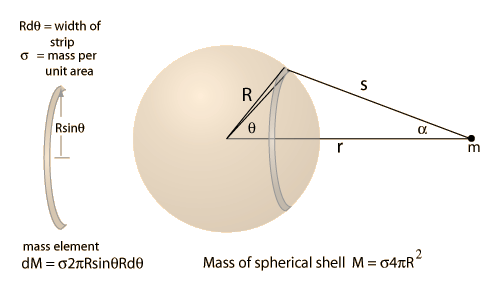 Image credit: R. Nave of http://hyperphysics.phy-astr.gsu.edu/.
Image credit: R. Nave of http://hyperphysics.phy-astr.gsu.edu/.
An amount proportional to the distance (R) squared.
So, mathematically, as you continue to consider larger and larger distances, you're adding a finite, non-decreasing amount of brightness. Which means that, if you're willing to consider arbitrarily large distances, you're considering arbitrarily large amounts of total flux. Over time, any dust that's in the way will heat up until it, too, begins to glow and shine. Meaning, once again, we'd have a night sky that looked like this.
Yet, the night sky is very clearly dark! There's a flaw in Olbers' Paradox, and you might have spotted it already if you noticed the words arbitrarily large up there.
You see, Olbers' Paradox first came up in 1823, a full 122 years before what we now know as the Big Bang model was even proposed. But we have overwhelming evidence for the Big Bang, and it teaches us a number of important truths about the Universe that contradict Olbers' (implicit) assumptions.
For starters, Olbers assumed the Universe was infinite in scale. This paradox only works if you're willing to take arbitrarily large literally, and consider a Universe that's infinite in extent!
Well, our Universe is certainly big; hugely, awesomely big, and extending far beyond the part that's observable to us. But the Universe is definitely finite when it comes to its age, checking in at about 13.8 billion years. This sets a limit to how big the observable part of the Universe is to us: about 46 billion light years in radius. So that's the first resolution to Olbers' Paradox: the part of the Universe that shines for us is not infinite, and so neither is the total amount of light that's transmitted in every direction! In fact, by looking in the visible, we can see just how bright the distant Universe actually is. It's impressive, for certain, but nowhere near infinite!
But there's more. You see, even if the Universe were infinite in extent, the stars in it don't live forever. (Olbers didn't necessarily know this, either.) Relying on the process of nuclear fusion to power them, stars come in a multitude of masses, sizes and colors, but they all have one thing in common: they all have a finite amount of fuel.
Even if the Universe were infinite in extent, the finite speed of light combined with the finite lifetime of these stars means that none of the stars that exist today will exist 100 trillion years from now. So even if the Universe went on forever, the light from a galaxy like ours, by time it reached its destination after a long enough travel-time, would have only the burned-out remnants of star systems to encounter.
But there's also one more reason the night sky is dark, and it's a reason that we're all less comfortable with: the fact that our vision, well, kind of sucks.
I mean, for our everyday purposes, it's great: we're well-adapted to the light that the Sun puts out. But remember that this is only a tiny, tiny fraction (like one part in 1030) of all the electromagnetic radiation that's actually found in the Universe!
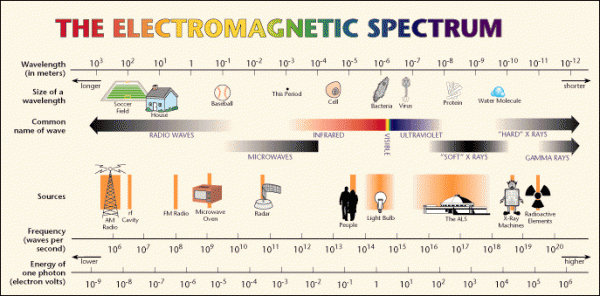 Image credit: MicroWorlds at Lawrence Berkeley Labs, via http://www.lbl.gov/.
Image credit: MicroWorlds at Lawrence Berkeley Labs, via http://www.lbl.gov/.
Because the Big Bang started from a hot, dense state, the relic radiation leftover from that actually does illuminate the night sky everywhere, in all directions! It's just that it illuminates the Universe at a temperature of about 2.725 Kelvin, about a factor of 1,000 too cool to be seen with our eyes.
That's exactly what the Cosmic Microwave Background is!
So the reasons the night sky is dark?
The observable Universe is finite in size, age, and number of stars.
The stars that exist haven't been around forever, and won't be around forever going forward, either.
And we can't see all the different wavelengths of radiation that abound in the Universe; the Universe is dark to our eyes because of the limited amount-and-types of light that we can see.
And that's a look into the dark depths of the Universe!



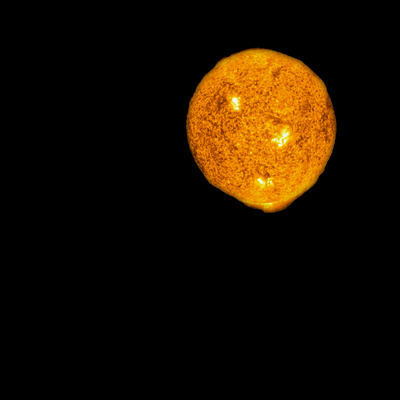

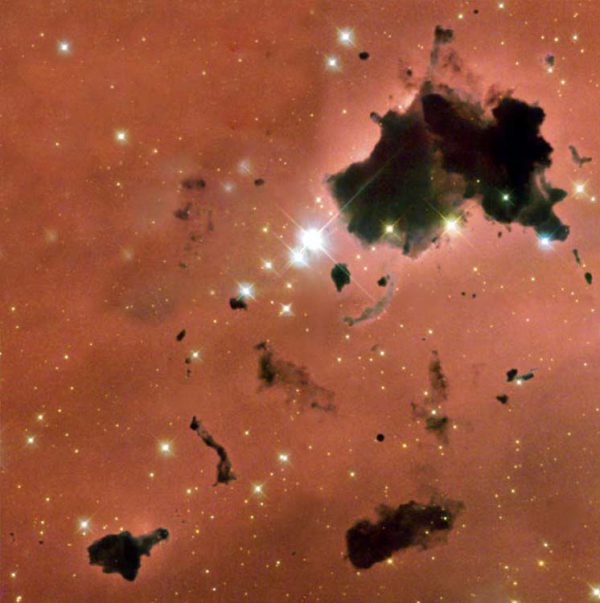
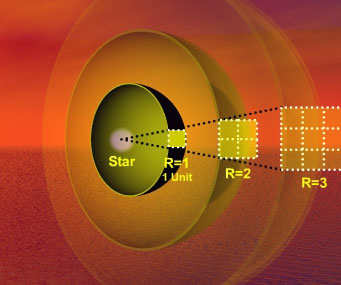
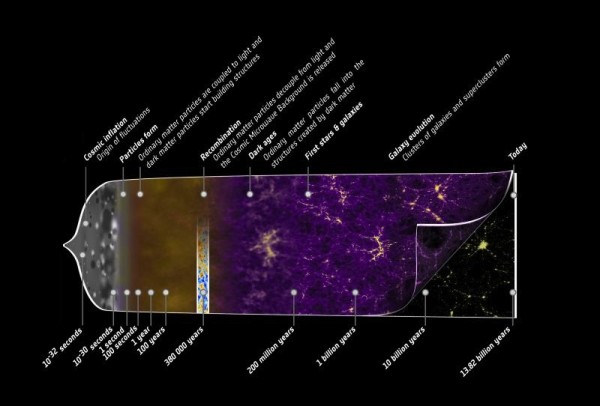

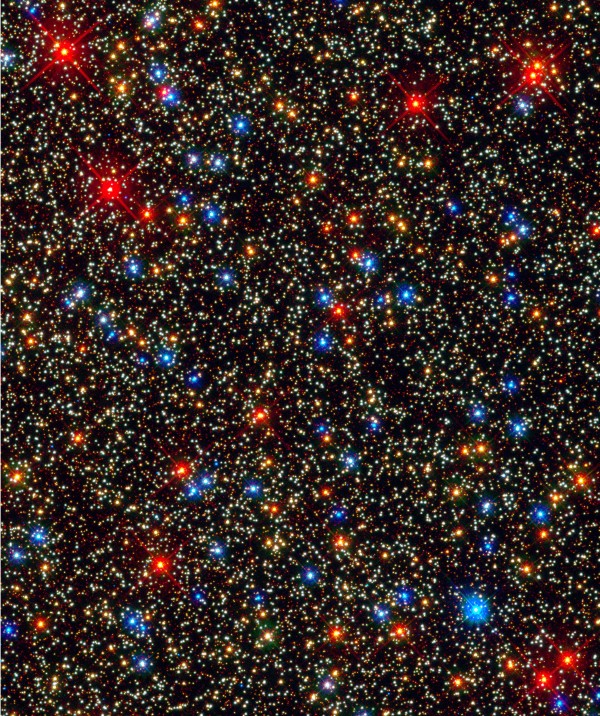
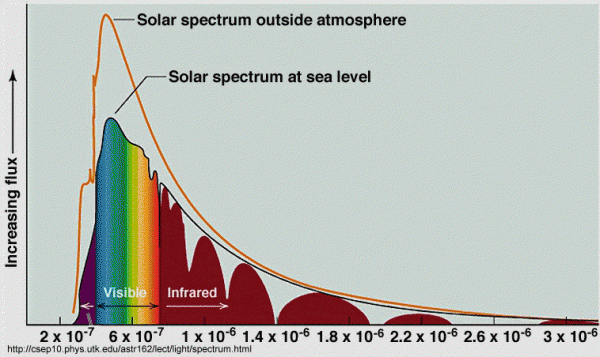
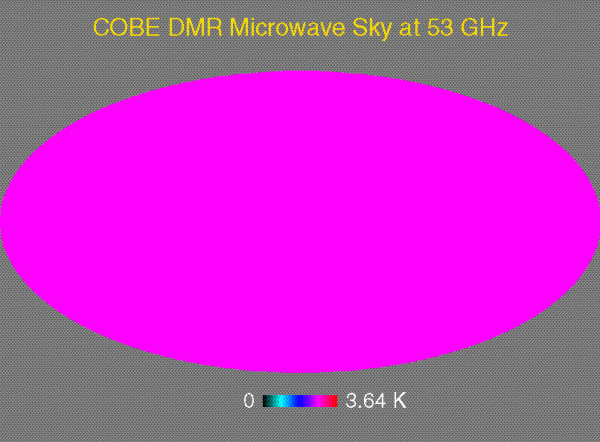

Nice. I particularly liked this: "the relic radiation leftover from that actually does illuminate the night sky everywhere, in all directions!" So if we were cold little creatures with microwave eyes living on some airless rock, the night sky would look white, not black. Somehow that's never occurred to me before.
THANK YOU! I have wondered about this for years, but I could never even figure out how to google for the answer!
It's going to take some digesting and mulling, though, before my feeble brain can absorb it.
So assume a device similar to the visor worn by LaForge on "Star Trek The Next Generation." Would a person wearing such a device be effectively blinded because her "vision" would be detecting so many spectra?
I don't think so Mike. I gather that some of the astronomy photographs you see are composite images made up of different spectra. But if we could "see" microwaves, at our ambient temperatures everything around us would be glowing, and our eyes too. So we wouldn't be able to see much. We'd have to be cold.
I don't think that Olbers paradox is very well stated in most accounts. The statement is essentially geometrical, but draws too many conclusions from that.
You need to know that the intensity of light decreases as 1/r^2 in order for the argument to work. That way, you can show that in an infinite universe the light levels would diverge. But if photons behaved, say, like mesons, and decayed as they travelled, then the geometric argument would fail.
Incidentally, I've never seen a proof that in an infinite universe every light ray actually does end in a star. It sounds simple to state, but there are infinite universe for which it is false. For example, If I create an infinite 2D universe where all the stars are located at integer (x,y) positions exclusing (0,0), then the line y=pi*x will never hit any star.
Actually, now that I think about it, the issue of whether there are rays which never hit a star is rather important.
For example, ask the question of whether there is a ray with largest length to a star. If such a ray exists then the summation over all rays must stop at this largest radius. But If such a ray does not exist then at any distance there still remains area of the sphere which is uncovered. But is this area dense on the sphere?
It's temptiong to apply the continuous approximation, but I'm not sure it can be made to work by argument alone.
o/t May i ask, sir, why do you not pitch in on social issues, at least once in a while? It would be 'bracing' to see a physicist's perspective on, let's say, the Zimmerman trial [and verdict]. Or, is that not just your [or this blog's] 'beat'?
I knew human senses were quite limited compared to other animals on this world, but the 1 in 10^30 part for the EM spectrum, wow. We really are limited by our physical limits. Thankfully, we have science to make up for it.
Nova,
I hesistate to post this because I really don't want to speak for Ethan or anyone else, but personally, I don't think discussion of social issues is really appropriate here. I come to read this blog to learn about and discuss scientific issues. There are MANY places on the internet where you could discuss the Zimmerman trial, why should it be here? Unless, of course, there is some scientifically interesting aspect of the case, which I don't believe is true in that particular trial.
Fabulous article! I'm having a problem with one thing though, picturing how a Universe 13.8 billion years old can have an observable radius of 46 billion light years. (Thank you Sean T! Now I don't have to comment, and I'm afraid mine would have been a little more forceful! There are too many social sites as it is!)
@Sean T
You may be totally right. But the reason i asked Ethan for HIS perspective was this: http://scienceblogs.com/startswithabang/2013/06/14/you-need-more-scienc…
:)
"His", i.e., a physicist's. :)
One does not follow from the other.
There is little in the way of science in the case you're talking about, therefore there's nothing to say on it here.
PS we do have a plethora of scientists. We have more than one, that means, just in case you didn't know what "plethora" means :-D
OMF:
There are additional assumptions in Olbers' Paradox beyond just a static universe that is infinite in age and infinite in extent, but they are minimal and reasonable and unlike the other assumptions still appear to be true as far as we can tell.
It also assumes the universe is homogeneous, so the density of stars and galaxies is roughly the same across the universe, and that the distribution is random and not organized in any meaningful way with regard to our point of observation (such as your stars only at integer multiples of some unit universe).
This is in essence the Copernican Principle. From this it is easy to see (and not hard to prove) that any line away from earth will eventually end in a star. Or to put it in terms of your decision problem: As distance X approaches infinity, the probability of the question "Is there a line from earth which exceeds distance X without intersecting a star?" approaches 0.
In the end, Olbers' paradox is false because it's assumptions are false. But the assumptions that are false are the infinite, eternal, static universe, not the Copernican Principle.
Sorry.
As distance X approaches infinity, the probability of the question “Is there a line from earth which exceeds distance X without intersecting a star?” evaluating to False approaches 0.
Sorry, I meant evaluating to True, of course.
"There is no whale." But i can't even pretend you would know what that means. ;)
Here is another way to look at just how tiny a sliver our eyes can detect of the electromagnetic spectrum. If you were to take the entire spectrum and extend it from Los Angeles to NYC the slice we can see with our eyes would be the size of a dime.
I believe the estimate of of 1 in 10^30 of the light in the universe being visible is incorrect. It's a little unclear since it's not obvious how it's being counted. However if we look at the energy density of the CMB in horribly non-SI units, it turns out to be a bitunder 1 ev/cm^3 (about 0.2 I think). We can estimate the energy density of starlight in the universe. The quickest reference I have is from Felten 1966 (ApJ), which is probably off by a factor of 10 or so given it's age, but it gives a metagalactic (outside the galaxy) energy density for starlight of 0.01 ev/cm^3. That's mostly in the visible. So in terms of energy density the two are quite comparable.
If you count photons, then since CMB photons have about ~10^8 times less energy, you get a another factor of 10^8 which might get us to 10^10 overall but you are still far short of 10^30.
Aside from this quibble on a minor point a very nice article.
How could he? The blogger makes no mention of the expansion of the Universe. The stars and Planets have been moving apart from one another for the past 13 billion years. In the distant past the sky was brighter. The expansion of space is the underlying reason for it all. Oblers Paradox is best explained by the expansion of space. All the reasons given are products of an expanding universe, not the reason why the sky is dark (Olber's Paradox)
I'm not satisfied. Just tell me why light disperses. Isn't that the point of the article? How about point it out that light is a wave (or a particle) and things (like dust) can stop it? Don't ask me, just speculating.
You don't know if the universe is infinite or finite. Even if it were finite, what is beyond its end? You don't know the age of stars or their longevity. You don't even know what makes them burn. You don't know what light is or even why we can see it.
So quit acting as if you know.
from what I have studied and saw the universe came from a white hole or worm hole I kept checking out the large mysterious void in the cosmic background upon close scrutiny of different cosmic back ground radiation maps I saw what appeared to be the remains of worm hole it has structure like fountain but is no longer working you can see concentric rings that are grow larger with distance from it. I saw articles referring to a large concentration of matter in a cosmic background wimp image, that structure is one of those rings. apparently it came from wave compression as matter flowed out from the wormhole. having its supply of matter depleted from the other end of the wormhole it now sits silent still having its disc structure.
What about the red-shift? Is that not also a reason for us not to see all the stars we could see, just because they're moving away from us so fast that their light is not visible to us, any more?
Mark: He did mention the Big Bang, which includes universal expansion and a finite age for the universe. Expansion would result in an event horizon where distant objects are moving away from us faster than light, but finite age is a better explanation for the size of the visible universe today. As the universe becomes increasingly dominated by dark energy (which wasn't known when Olbers' Paradox was resolved), then yes, expansion will be the reason there's nothing interesting in the sky outside the local galaxies.
But either way that's not the reason why stars have finite age or our eyes see only a limited portion of the spectrum.
Paul Revere: The point of the article isn't to establish that light diminishes as the square of the distance. That's pretty simple to show with geometry and conservation of energy, regardless of what light actually is. Hypothetically it could fall off faster than that (but empirically does not), but not any slower.
Dust clouds aren't the cause. As Ethan mentioned, that dust would be heated up by all the starlight it absorbed and start glowing on its own.
If you do want a good intro into the nature of light (spoiler: It *is* corpuscular like what we think of as a particles, and has some classical wave-like features, but isn't really a classic particle or classic wave but something different and much more bizarre) I recommend starting with this math-light and highly approachable lecture from the master himself:
https://www.youtube.com/watch?v=eLQ2atfqk2c
Steffen Moller: As I said to Mark, at some point stars being red-shifted out of our visible universe will be the dominant reason why we can't see distant objects, but today it's the finite age of the universe. Even things that aren't moving away so fast that we couldn't ever see them nevertheless are too far away for their light to have had the chance to reach us. Both concepts are part of the Big Bang, though.
Those were good questions and comments. Now...
Usul: Correct, as Ethan said, we do not know if the universe is infinite in size or not. Olbers _assumed_ the universe was infinite in size and age, and worked out the consequences. The resulting paradox implies that one of those assumptions is wrong. Today we know* that the assumption of infinite age is wrong, and as a direct consequence the size of the _visible_ universe is finite. Whether the universe as a whole is infinite in size or not is still unknown. However even if it is finite that doesn't mean there's an "edge" that has to have something "beyond" it. It's pretty easy to find geometries that are finite in size but boundary-less.
gerald jackson: That's nice. Formulate your idea into a rigorous and quantitative hypothesis, run the math, compare to WMAP or Plank data, and publish.
* I mean "know" in the sense of this Stephen Gould quote: "In science, 'fact' can only mean 'confirmed to such a degree that it would be perverse to withhold provisional assent.' " In this sense we know for a fact that the universe is finite in age, what stars are made of and how they burn, and what light is.
The word "provisional" is very important; we could be wrong. Probably are wrong, though particularly in the case of light the degree of possible wrongness is highly constrained by our measured correctness.
Great piece CB is correct when he implies correct epistemology and method must be utilized and employed in order for deductions to be in accordance with reality; "ggarbage in, garbage out", as the expression goes. "Every unit of length, no matter how small, has some specific extension; every unit of time, no matter how small, has some specific duration. The idea of an infinitely small amount of length or temporal duration has validity only as a mathematical device useful for making certain calculations, not as a description of components of reality. Reality does not contain either points or instants (in the mathematical sense). By analogy: the average family has 2.2 children, but no actual family has 2.2 children; the “aver
Please disregard the final sentence fragment beginning "By analogy..." Clipboard error on my part.
Jamus Hurlbut:
Every non-zero quantity is a non-zero quantity, yes, how droll.
What matters, though, is whether there is a minimum non-zero quantity which cannot be further divided into smaller ones. If yes, then that metric is discrete. If not, then the non-zero quantities can become arbitrarily small. Which is the same as infinitely small. Take any non-zero quantity, and it can be divided into infinitely many sub-units. That metric is continuous.
We don't know whether the space-time metric is discrete or continuous.
"Reality does not contain points" is an assumption based on discomfiture with the fact that you can't take some finite length, divide it in half, and repeat until you reach "infinitely small" in a finite amount of time. However maybe rather than disregarding the math, you should look to the fact that the math deals quite nicely with the continuous without having to engage in the iterative approach. Why should the universe have to?
This is basically like saying that the universe cannot be infinite in extent because if you hopped in a spaceship of finite velocity you couldn't reach the end of the universe and find infinity before you died.
Good piece. However, there is yet another point that is generally discussed about - the density of stars in the vast space. If you are in a small room with one 100 W bulb, that could be bright, but imagine a vast room with several 100 W bulbs 'randomly distributed' but still each at 1 km distance from each other. You will see only darkness.
Only if the room is small compared with the 1km spacing, Mohan.
Imagine the room is 10 light years across with one light bulb per km.
The milky way is quite visible as a continuous veil of light because, despite the gap between stars being ~5 light years and the suns therein only a few light seconds across (~10^-5 times the volume). And it'd be lighter if it weren't for the obscuring dust.
It does add up.
Mohan Ramanathan:
The necessary assumption is that the density of stars does not trail off towards zero as distance from earth increases. It doesn't even have to be a very high density; it just has to be non-zero and non-decreasing. It could be a little less than it is locally, we could be at a slightly higher density region than average, but overall the universe should look about how it does to us here and then we get the paradox.
This assumption is known as the Copernican Principle or Cosmological Principle. So far it is has still held up. The other assumptions of Olbers' Paradox have not.